
Marriage Portrait of Martin Luther and Katharina of Bora (1525 – 1526)
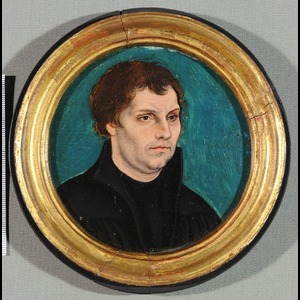
Abb. 1: Lucas Cranach d. Ä. [und Werkstatt], Doppelbildnis Martin Luthers und Katharina von Boras, 1525, Malerei auf Buchenholz, Öffentliche Kunstsammlung Basel, KKL-Nrn. III.M1a und III.M1b
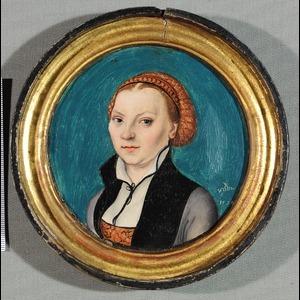
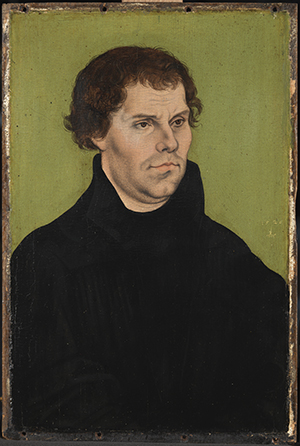
Abb. 2: Lucas Cranach d. Ä. [und Werkstatt], Doppelbildnis Martin Luthers und Katharina von Boras, 1526, Malerei auf Buchenholz, Nationalmuseum, Stockholm, KKL-Nrn. III.M8a und III.M8b
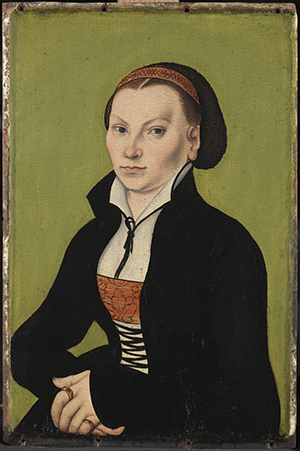
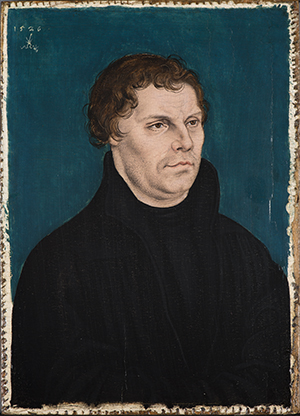
Abb. 3: Werkstatt Lucas Cranach der Ältere, Doppelbildnis Martin Luthers und Katharina von Boras, 1526, Malerei auf Holz, Privatsammlung, KKL-Nrn. III.M16a und III.M16b
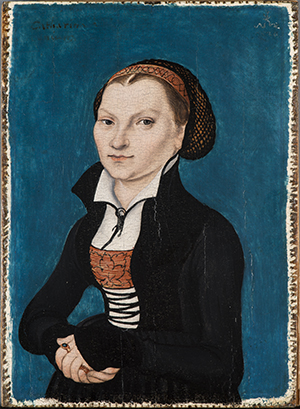
At the latest by 13 June 1525, the date of Martin Luther’s engagement to Katharina of Bora, a large number of double portraits[1] were produced in the Cranach workshop, representing the couple in different picture formats.[2] Luther is depicted bareheaded in a black gown with a stiff collar against a blue or green background. His gaze, which is turned to the right, establishes a relationship with the portrait of Katharina of Bora conceived as its companion piece. Her black dress with its stiff collar harmonizes with the garment of her companion. A net trimmed with brocade covers her brown hair. Unlike Luther she fixes her gaze on the viewer. As was traditional for marriage portraits Bora occupies the right-hand (heraldic left) side (fig. 1, 2 and 3).
Function
Portraits of married couples and families fulfilled a representative function by displaying the sitter’s rank and social status. They documented family and social affiliations and moreover also served as ‘memoria’. The aristocratic practice of commissioning series of genealogical portraits and having ancestral portrait galleries was also introduced to bourgeois circles by the late Middle Ages. Portraits were exchanged and gifted, providing both identity and community. In addition to engagements and weddings, births, deaths and changes of status were also customary occasions for portraiture.
Not only did the mass-produced marriage portraits of Martin Luther and Katharina of Bora have the function of documenting their relationship, but it evidently also had an exemplary role, which according to early modern conviction was intrinsic to portraits.[3] It presented the reformer in new private and public contexts and was designed to prompt the viewer to imitate the exemplary Christian way of life embodied by him. Alongside emperors and dukes, Luther and Katharina decorated the living quarters for example of the Nuremberg family Scheurl and were received in effigie into the family as role models.[4]
Historical Context
In his text on marriage from 1522[5] Luther not only publicly expressed himself in favour of a revaluation of marriage as opposed to celibacy, but also from 1523 actively supported the marriage of priests (as for example in the case of the lay preacher, Wenzelaus Linck from Altenburg, whose wedding he attended in 1523).[6] Therefore by the end of 1524 Luther was publicly urged to marry but he initially rejected the idea with reference to the work of the Antichrist and his expected martyrdom.[7] It wasn’t until early summer that Luther became increasingly convinced that marriage was required of him in obedience to God‘s commandment and as a sign of his opposition to the clerics whose stance was inimical to God.[8]
In an open letter to Cardinal Albrecht of Brandenburg, only a few days before his own marriage, he claimed that the cause of the Peasant War was a hatred of the clergy and advised him to marry so that ‘the reasons for indignation would be taken from Satan’.[9] Luther’s friends and companions criticized this surprising turnaround, because they felt it to be an inappropriate moment, saw Luther as a victim of his own sensuality or did not consider Katharina of Bora to be the right candidate.[10]
Bora had been among those nuns, who had fled from the Nimbschen Convent to Wittenberg, where Luther sought to accommodate or marry off those who could not return home.[11] As no suitable husband could be found for Katharina of Bora she initially lived and worked in the household of Lucas Cranach the Elder,[12] until Luther became engaged to her on 13. June 1525 in the presence of a small circle of friends, including Cranach, his wife, Justus Jonas, Bugenhagen, as the local pastor and the lawyer, Johann Apel who was also married to a nun.[13] However Cranach and his wife were not among to guests who attended the church wedding ceremony and meal that took place with considerable expense on the 27 June.[14]
News of Luther’s engagement spread quickly to the public via the correspondence between the Wittenberg reformers – not least because late medieval perception viewed the marriage of a monk and a nun as an apocalyptical sign.[15] Cardinal Albrecht of Brandenburg sent Luther a wedding gift of twenty gold guilders.[16] The Cranach workshop and its numerous employees appear to have satisfied the wide public interest in Luther’s marriage by producing a large number of double portraits.[17] Of these 13 portrait pairs are known today and numerous single portraits, for which companion pieces would presumably have originally existed (III.M1–III.M19).[18] As the marriage was quite a surprise, even for Luther’s closely trusted friends, it may be assumed that the first portraits didn’t leave the workshop until the middle of the year. The very traditional type of the marriage portrait chosen by Cranach served an important function as witness to the marriage and as role model for a Christian way of life, but more significantly it placed the marriage, which according to canon law was illegitimate, within an existing pictorial tradition. This conventional model, which was certainly easy to reproduce, was executed for the most part on small transportable panels, but without neglecting more representative formats.
In view of this it is not surprising that Luther’s opponents also reacted to the portraits. The Dominican prior of Magdeburg Johannes Mensing challenged the circulation and the veneration of portraits of Luther and his wife and complained that ‘[…] the picture of the one against Christ/Luther with his runaway nun/they [Luther’s followers] put it instead [rather than an image of Christ] in their houses and bedrooms’[19] An invective written by Johannes Fabri, the humanist and later Bishop of Vienna in 1528 attacks the priests’ marriages of the reformers. In it he condemns the fact that ‘Luther, Zwingli and Oecolampad took, as wives rich, beautiful women / they make their way in with golden chains/rings/and silk dresses/like countesses’. Then Fabri addresses Luther directly by continuing: ‘[…] how one had to portray your runaway nun in a silk dress / and golden bonnet / on your wedding day/’.[20]
[1] It may be assumed that the few single examples were originally paired with a Bora pendant, although the exceptional cases of a single portraits are also conceivable.
[2] As small-format round portraits (nine panels), as large-format rectangles (six panels) as well as small-format rectangles (17 panels).
[3] See for example Dodgson 1909, pp. 194-196.
[4] See Soden 1837, p. 89.
[5] WA 10/II, pp. 267–304.
[6] See Moeller 2001, pp 194-218.
[7] See Brecht 1986, p. 195; and also Schubert 2015, pp. 44-65, esp. pp. 51-52.
[8] „dem Satan die ursachen der empörung genumen würden“, see Breul 2010, pp. 153-168, ibid. p. 163.
[9] WA 18, p. 409, lines 1-3.
[10] Brecht 1986, pp. 197-198.
[11] Generally regarding this subject see ibid. pp. 194-203.
[12] ibid., p. 194.
[13] Köstlin/Kawerau 1903, p. 734 suggest that Cranach may have given Katharina away; in Ozment 2012, p. 114, Cranach is Luther’s substitute father-in-law (!), which is not confirmed by primary sources.
[14] See the list of guests in Köstlin/Kawerau 1903, p. 735.
[15] See Oberman 1986, p. 292.
[16] Köstlin/Kawerau 1903, p. 138; Old faith polemics against Luther’s marriage were known since 1527. See Roper 2016, p. 365.
[17] The earliest, some only known from the sources, were copied and adapted shortly after they were produced. In the Nuremberg Art Collection of Paulus II. Praun (1548-1616) two works are recorded that are described in the second inventory of the Praun Collection from 1719 as: ‘Dr. Luther and his wife portrait on paper in watercolour, painted in two round frames’ (“Dr. Luther und deßen ehefrau contrefait auf papier von waßerfarb, in zweyen runden rämlein gemahlt.”) (Katrin Achilles-Syndram: Die Kunstsammlung des Paulus Praun. Die Inventare von 1616 und 1719, Nürnberg 1994, p. 185, no. 44). The same works are mentioned by Murr 1797, p. 8, no. 48 and 50, adds additional information. The panels are dated 1531 and by an unknown master.
[18] Three tondi and 10 rectangular works survived as pairs.
[19] „[…] das bilde des widderchristus / Luthers sampt seyner aussgelauffen Nonnen / setzen sie [die Anhänger Luthers] an die stad [statt des Bildes Christi] ynn yren heussern und schlafkamern.”, Mensing 1526 [VD16 M 4653], fol. A iir. See Kramer 2017, pp. 223-225.
[20] „[…] wie man dann in einem seydenen cleyd / und guldener hauben / dein auszgeloffnen Nonnen auff deiner hochtzeit / hat mussen abcontrafeyen.“, Fabri 1528 [VD16 F 196], R 4r. See Kramer 2017, pp. 225-226.
Observations on the painting process
The surviving portraits from this group are panel paintings that were produced between 1525 and 1526 (fig. 4).[1] These can be divided into three subgroups according to their size and format. The earliest of these are the small round portraits dated 1525 and with a diameter of about 13.5 cm (III.M1–III.M6).[2] The upright rectangular versions have survived in a smaller variant against a blue background (III.M11–III.M19) and a larger variant against a green background (III.M.7–III.M10). Both the image and the format of the latter are about twice the size.[3] The portrait on the smaller upright format is about the same size as that of the round panels with one exception.[4] All the portraits from this group were executed on beech panels.[5]
[1] A woodcut attributed to the Holbein workshop transferred the Cranach Luther tondo to the medium of print, but is not within the time frame selected for the investigations undertaken by the KKL. See the appendix with a list of works eliminated from the KKL. Dendrochronological examination of four examples supports the assumption that the year on the portraits corresponds with the year of their production. See the catalogue entries for the individual works.
[2] Today the dimensions of the surviving examples vary between 10 and 13.5 cm, which can in part be ascribed to later cropping of the panels.
[3] The dimensions of the larger formats are about 40 x 27 cm (Standard format B, according Heydenreich 2007) in contrast with 22.5 x 16 cm for the smaller formats (Standard format A according to Heydenreich), and Luther’s head has a height of between 14.5 and 7.4 cm.
[4] Only the portrait on the round panel in Basel (III.M1) is smaller, a fact that is coupled with the more expansive background.
[5] The reasons for choosing a wood type that was - bar a few exceptions - at this time in Europe completely unconventional has been associated most recently by Heydenreich 2017, p. 257with Cranach’s temporary activity as a publisher and the printing office he ran with Christian Döring between 1523 and 1526. It seems logical that the panels, which correspond in wood type, thickness and format with book covers of contemporary bibles, were made by a carpenter who delivered boards for both purposes. See also Heydenreich 2007, pp. 42-47, Heydenreich 2017, pp. 257-258; Neuhoff 2017, p. 259.
The round portraits (III.M1–III.M6) transferred the format and conventions of representation known from portrait medallions to the medium of paint. This genre was extremely popular in 16th century humanist circles, not least because of its origins in antiquity.[1] By satisfying this demand with painted portraits Cranach adopts a portrait type that is new for the German-speaking world.[2] Both the reference to the commemorative role of the medallion and the innovative shape of the painting suggest it may have been designed to ennoble Luther and Bora.[3] The small format also facilitated speedy production and ease of transportation. The composition of the frame that was probably turned and consisted of interlocking parts was of benefit for this purpose. The round panels that were c. 4 mm thick and finely finished on the reverse could thus be joined together to form a closed ‘capsule’ which protected the portraits (fig. 5a and b).[4]
[1] See generally Exhib. Cat. Munich 2013.
[2] Before 1525 only a few examples of this type have been found. See Dülberg 1990, cat. nos. 31 and 32 as well as Schwarz-Hermanns 2007, p. 121.
[3] That the sitters also considered round painted portraits to have ‘a certain added value’ is suggested by the fact that round portraits of this type exist depicting Friedrich II of Saxony [dated 1525, see Cranach Digital Archive: DE_SKK_0120](https://lucascranach.org/DE_SKK_0120) and Cardinal Albrecht of Brandenburg (dated 1526, see Koepplin, Falk 1974, Bd. I, p. 275, fig. 141) even though both rulers had already had themselves represented several times on portrait medallions.
[4] The interlocking frame has survived on the examples in the Kunstmuseums Basel (III.M1). For further examples of portraits that can be joined to create a closed capsule see Dülberg 1990, cat. nos. 34, 35, 264, 269.
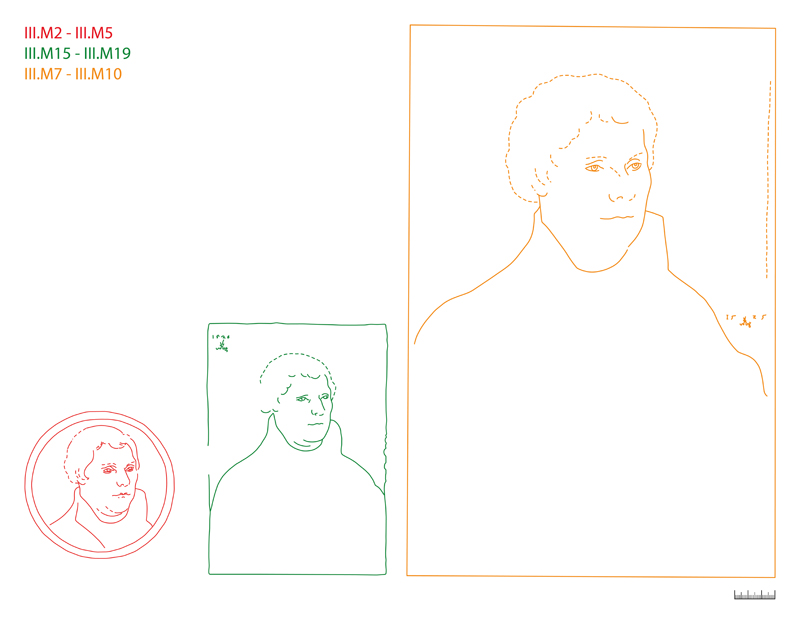
Abb. 4: Die Gemälde der Bildnisgruppe 3 wurden in drei unterschiedlichen Formaten hergestellt.
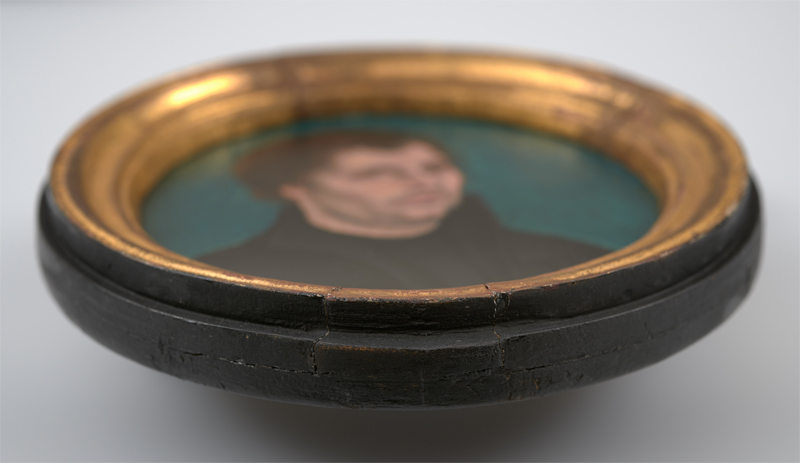
Abb. 5a: Die Basler Rundbildnisse (III.M1) ließen sich durch korrespondierende Rahmenprofile zu einer Kapsel verschließen.
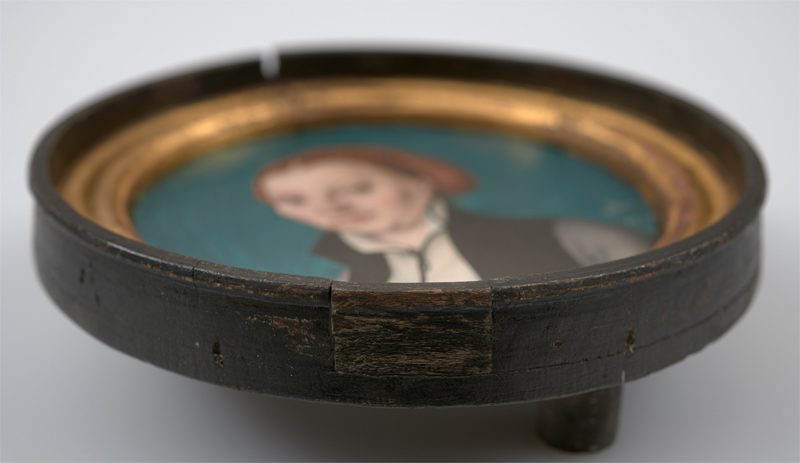
Abb. 5b: Die Basler Rundbildnisse (III.M1) ließen sich durch korrespondierende Rahmenprofile zu einer Kapsel verschließen.
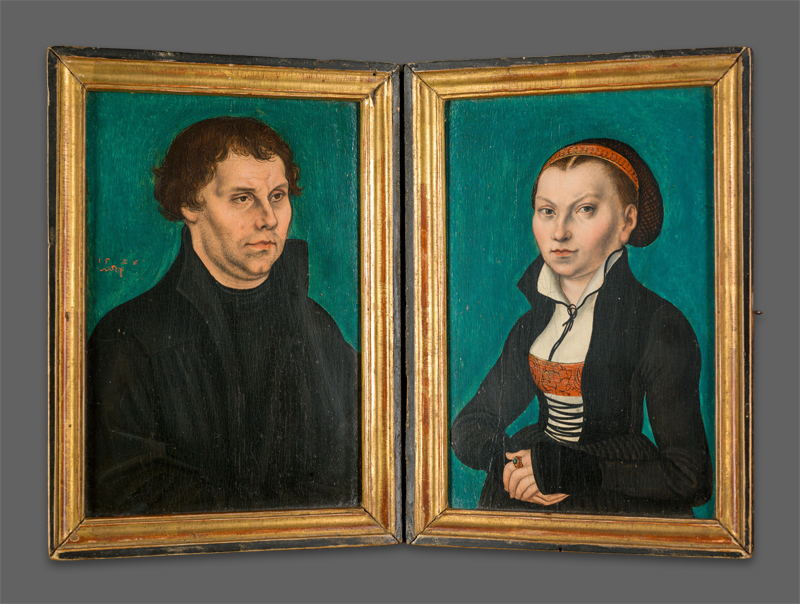
Abb. 6: Lucas Cranach d. Ä. [und Werkstatt], Doppelbildnis Martin Luthers und Katharina von Boras, 1526, Malerei auf Buchenholz, Herzog August Bibliothek Wolfenbüttel, KKL-Nrn. III.M11a und III.M11b
The small upright rectangular beech panels of a standard size (III.M11–III.M19) also exhibit a uniform thickness of about 4 mm and are carefully smoothed on the reverse as well. Gilded frame members were glued to the edges of the panel and both panels of a diptych were probably originally hinged together, allowing them to be opened and closed like a book.[1] In this respect they are in keeping with the hinged marriage diptychs that had become increasingly popular in 16th bourgeois circles. These could be opened and displayed as family documents on special occasions. The hinge made it possible for them to be stored closed and also facilitated transport or dispatch of the panels, which would in turn have expanded the target group of customers. A uniform dark brown to black coating was applied to the reverse and the exterior of the frames and the panels do not exhibit any of the decorative elements typical of double portraits at this time.[2] The omission of these painted elements on the reverse certainly permitted a quicker and cheaper production of the portraits, but could also be interpreted as evidence that they were displayed on a wall (fig. 7).[3]
The larger format panels (III.M7 to II.M10) are painted on thicker boards averaging about 1 cm thick and finished in various ways on the reverse. Whereas the reverse of the Bristol work (III.M7), dated to 1525, is grooved on all four sides and only smoothed to a certain extent, and so is similar to the treatment of the earlier ‘Junker Jörg’ portraits, the panels of the Stockholm double portrait (III.M9), dated to 1526 are bevelled all round to a thickness of 5 mm and so exhibit similarities with the panels from Portrait Group IV (Luther as a Married Man with Gown and Cap), that were produced after 1528. The different finishes on the reverse can probably be associated with the increased serial production and the rationalization of the production process: whereas in the Middle Ages traditionally the carpenter produced the frame and panel as a unit with a ground application, Cranach abandoned this approach, increasingly using panels of standardized formats that were then framed after completion of the painting.[4]
[1] Original hinges have not survived. On the example in Wolfenbüttel (III.M11) remnants of glue on the neighbouring frame members – when open - as well as a loop and numerous holes on the outer battens document the earlier mounting of a hinged locking mechanism.
[2] See Dülberg 1990, pp. 65–83.
[3] In Christoph Scheurl’s estate inventory from 1542 the description of portraits of Luther and Bora hanging under an altane ‘in the room opposite the courtyard’ (cited after Soden 1837, p. 89) suggests that they were mounted on the wall. And if one believes the report in Luther’s ‚Table Talk‘ then there was a single Cranach portrait of Katharina of Bora hanging on the wall in the reformer’s house. (see WA TR, Bd. 3, p. 379, lines 1–6).
In the Cranach workshop an economical solution for the serial production was developed where a decorative element was of significance, like for example with the double portraits of Friedrich III of Saxony and his brother and successor Johann that were produced in large numbers from 1532. A printed electoral coat of arms was pasted to the reverse of the portrait of Friedrich and has survived on many examples see: [DE_KSW_G7](https://lucascranach.org/DE_KSW_G7); (DE_smbGG_636](https://lucascranach.org/DE_smbGG_636); [HU_SMB_1341](https://lucascranach.org/HU_SMB_1341);
[CZ_NGP_DO4573](https://lucascranach.org/CZ_NGP_DO4573);
[CH_KMBe_G0591](https://lucascranach.org/CH_KMBe_G0591);
[F_MdLP_1181](https://lucascranach.org/F_MdLP_1181);
[UK_BM_SLPictures-271](https://lucascranach.org/UK_BM_SLPictures-271); see also Heydenreich 2007, p. 126.
[4] See Heydenreich 2007, pp. 75-89. Heydenreich in: Exhib. Cat. Frankfurt 2007, pp. 29–47.

Abb. 7: Lucas Cranach d. Ä. [und Werkstatt], Bildnis Martin Luthers, 1525, Malerei auf Buchenholz, Kulturstiftung Hansestadt Lübeck, die Lübecker Museen, KKL-Nr. III.M4
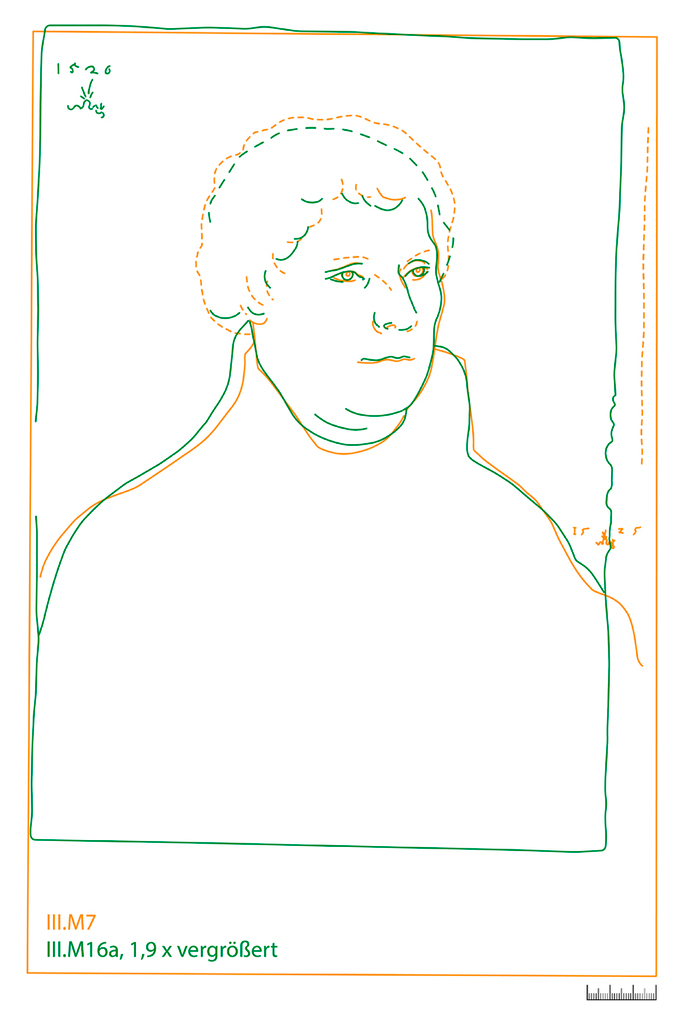
Abb. 8: Der Darstellungsmaßstab der großen Tafeln weist etwa die doppelte Größe gegenüber dem der kleinen Tafeln in Rechteck und Rund auf. Hier Überblendung der Umzeichnungen des Bristoler Gemäldes (III.M7) in Orange und des Bildnisses in Privatbesitz (III.M16a) in Grün
Although the consistently thin lines of the underdrawing within the Portrait Group vary considerably in detail according to the format of the painting it can be assumed that the facial contours of all three formats were transferred with the assistance of a template.[1] The portrait could thus be reproduced in different sizes. The fact that the facial contours match when scaled suggests that the same portrait drawing was employed on different- sized templates to transfer the design (fig. 8).[2]
[1] Frequently no, or only occasional, short lines on the nose, eye or philtrum were observed on the round portraits, whereas these are both more evident and more extensive on the small-format upright rectangles, and on the larger-format example in Stockholm (III.M8) attain the scope and character of the similarly-sized portraits in Group IV.
[2] This subject is addressed in more detail in an essay (in progress) on the techniques employed for the Luther portraits.
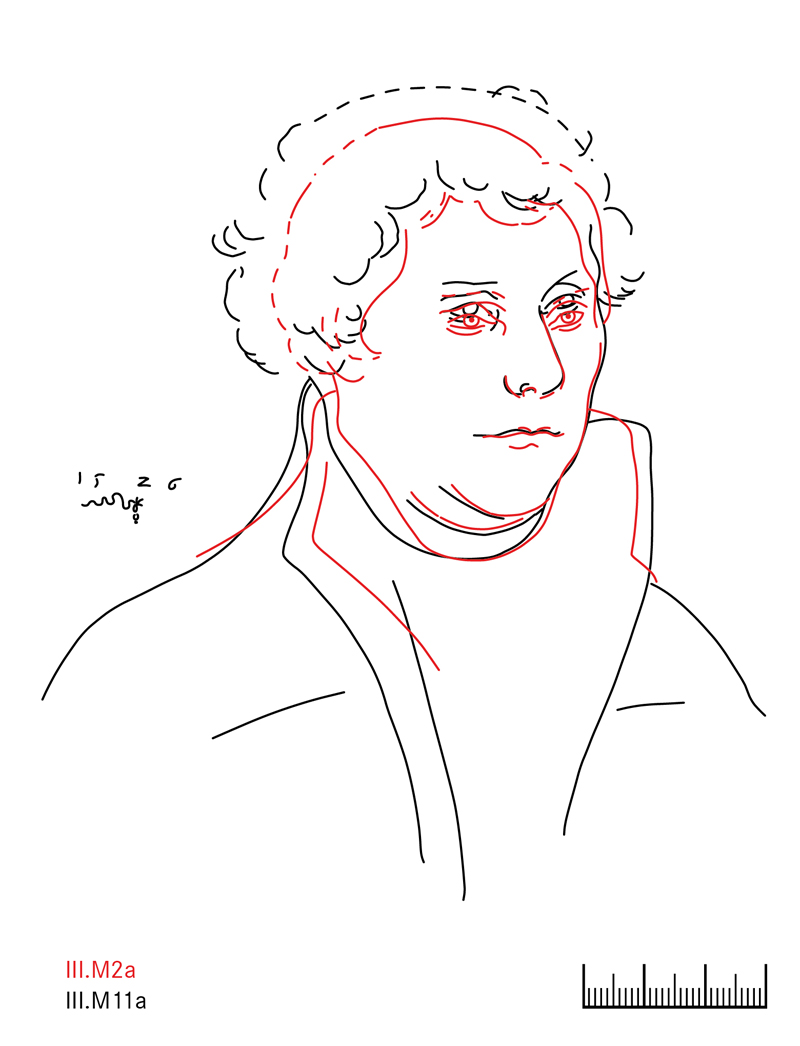
Abb. 9: Die kleinformatigen Bildnisse wurden in zwei geringfügig voneinander abweichenden Darstellungsmaßstäben gerfertigt. Hier Überblendung der Umzeichnungen des Wolfenbüttler Gemäldes (III.M11a) in Schwarz und des Wittenberger Rundbildnisses (III.M2a) in Rot
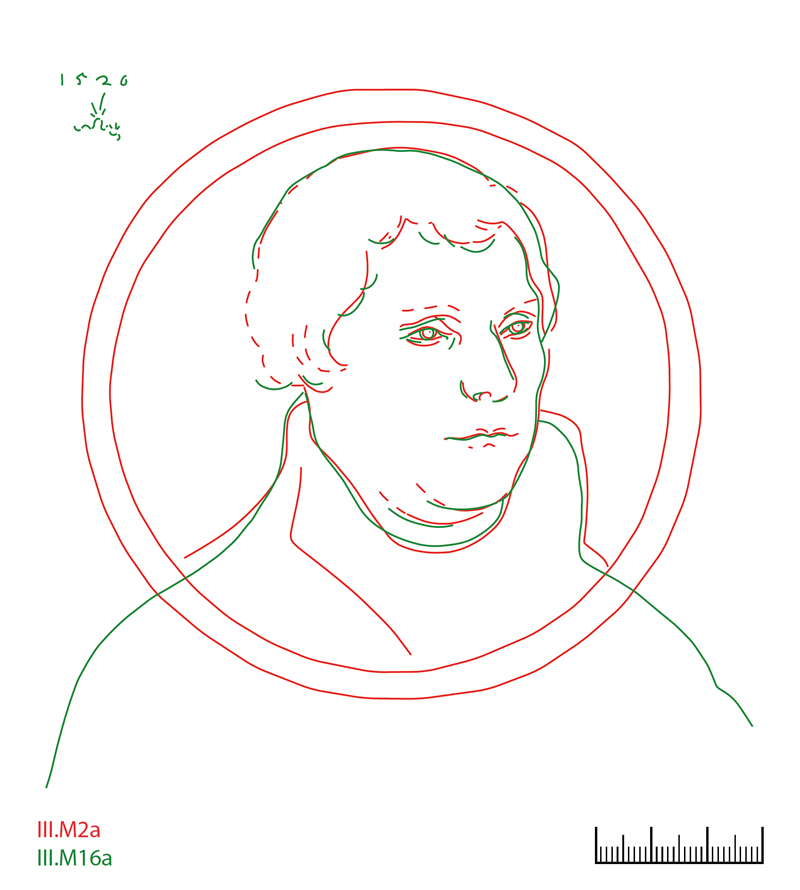
Abb. 10: Die Exemplare mit kleinerem Darstellungsmaßstab entsprechen sich in den Gesichtskonturen exakt. Hier Überblendung der Umzeichnungen des Bildnisses in Privatbesitz (III.M16a) in Grün und des Wittenberger Rundbildnisses (III.M2a) in Rot
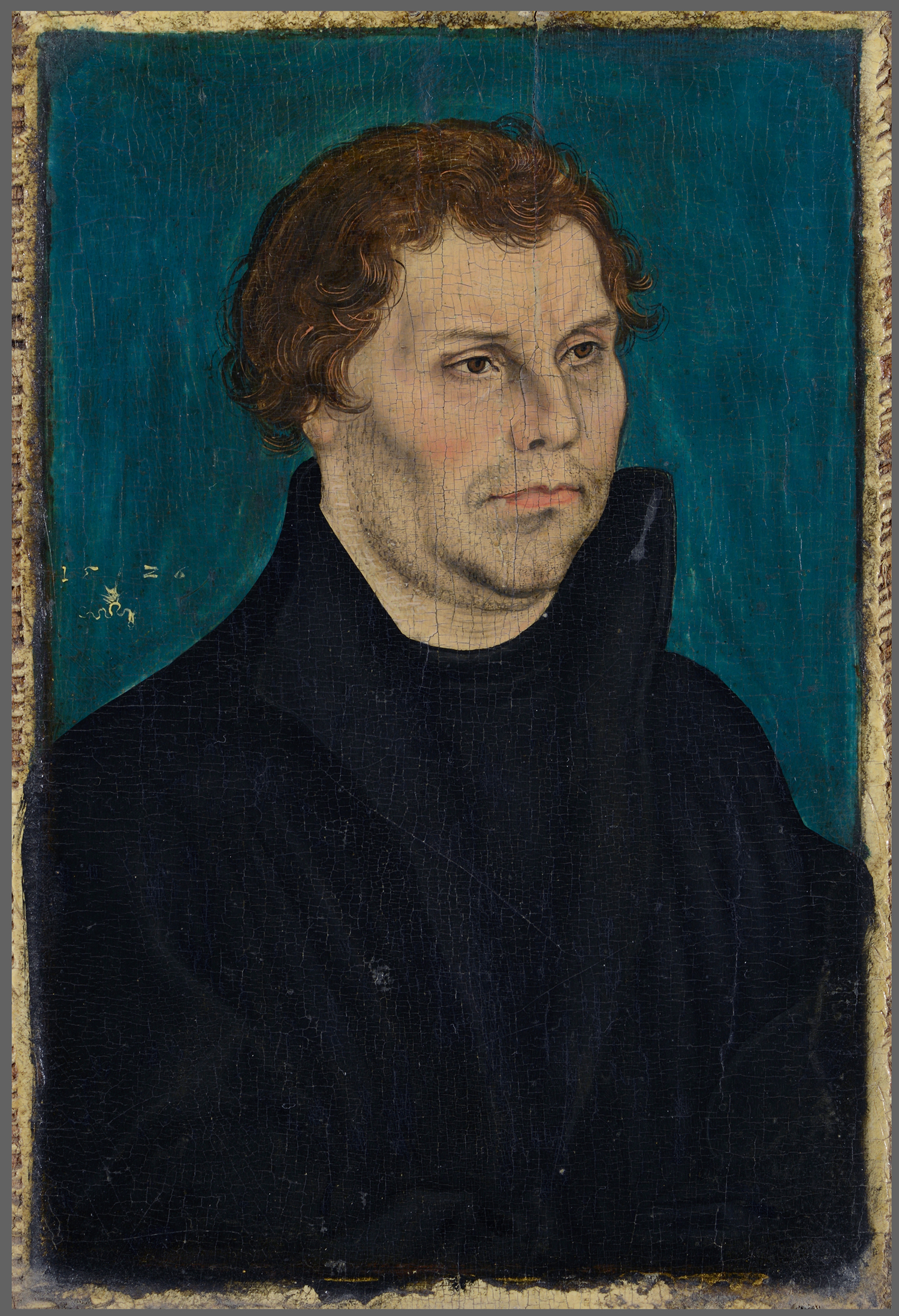
Abb. 11a: Die Unterschiede zwischen Exemplaren der kleinen rechteckigen Tafeln zeigen sich neben dem leicht abweichenden Darstellungsmaßstab auch in der Position und Ausführung der Signatur sowie in malerischen Details. Hier das Gemälde der Wartburg-Stiftung Eisenach) (III.M12a) neben dem Bildnis in Privatbesitz) (III.M16a)
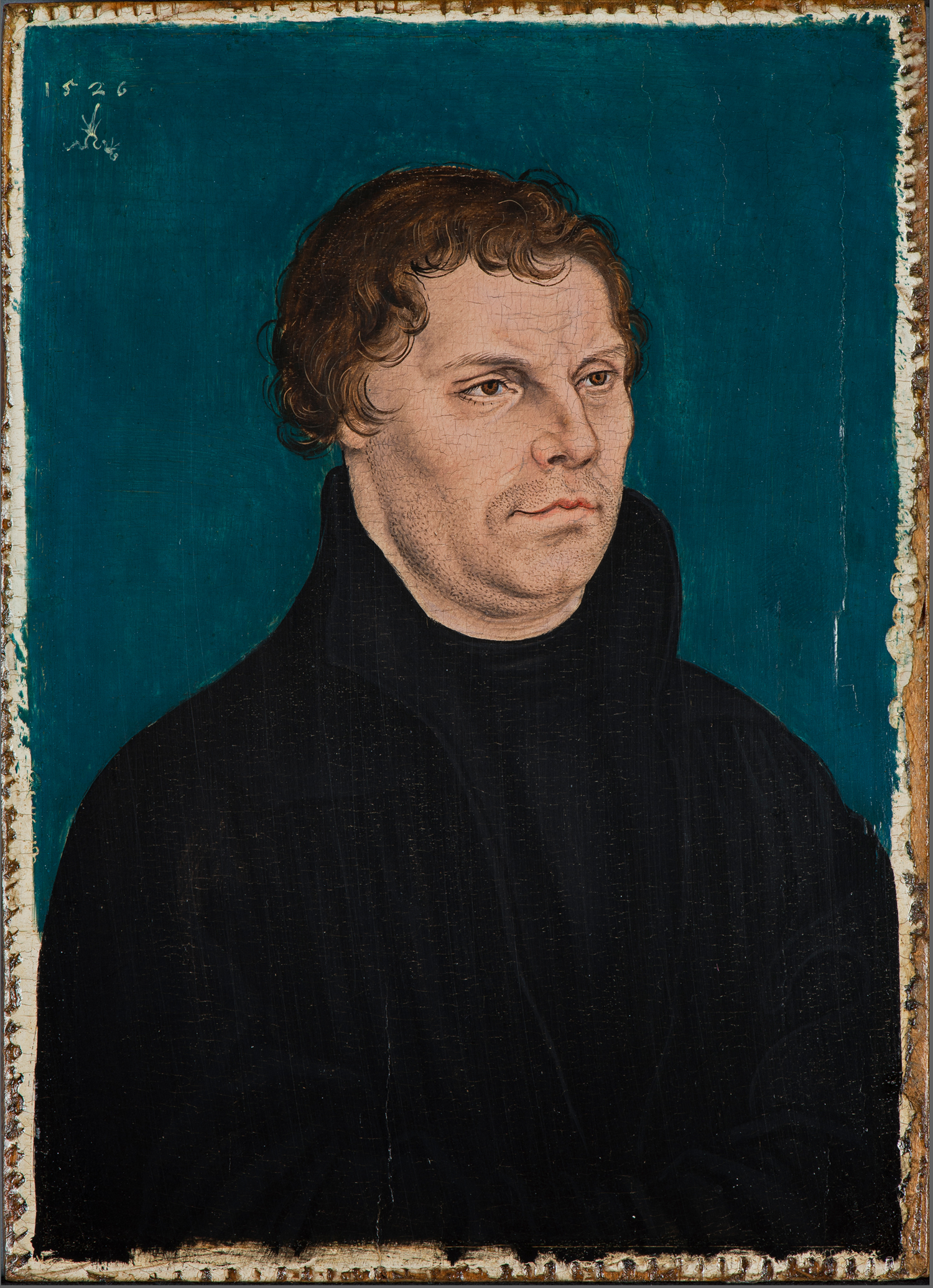
Abb. 11b: Die Unterschiede zwischen Exemplaren der kleinen rechteckigen Tafeln zeigen sich neben dem leicht abweichenden Darstellungsmaßstab auch in der Position und Ausführung der Signatur sowie in malerischen Details. Hier das Gemälde der Wartburg-Stiftung Eisenach) (III.M12a) neben dem Bildnis in Privatbesitz) (III.M16a)
A very minor deviation in scale among the small upright rectangular formats is discernible (III.M11–III.M19) (fig. 9). Whereas some examples correspond exactly in size with the depiction of the round portraits,[1] others are slightly larger and match each other (fig. 10).[2] This suggests the use of two templates of slightly different scales within the portrait series.[3]
[1] These are III.M.15a, III.M16a, III.M17a and III.M18a and III.M19a. Based on the corresponding image size it can be assumed, that the same template was used for these examples and the majority of the round portraits. Only the version in Basel (III.M1) is slightly smaller in scale and cannot have been created using the same template.
[2] These are III.M11a, III.M12a, III.M13a und III.M14a.
[3] The underdrawings of the larger versions (examined on III.M11 and III.M12) are very faint and only sections are visible in the infrared reflectogram. They appear to have been executed in a different medium, using a different technique from the one employed for the underdrawings of the smaller images.
[4] The example in Schleswig III.M15a is an exception with the insignia positioned above Luther’s shoulder even though it is one of the smaller versions with a rounded ‚2‘. However, the insignia probably had to be positioned elsewhere because of the inscription added to the top edge.
[5] This is the only way to explain the simultaneous appearance of a characteristic underdrawing, painting technique and signature. See also Heydenreich 2007, pp. 289-291.